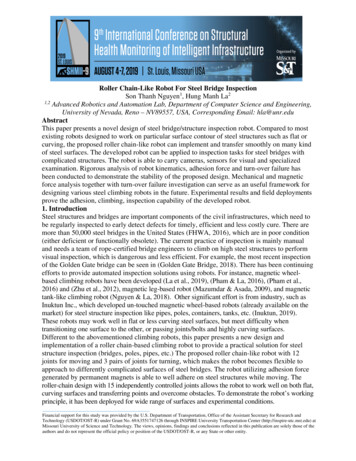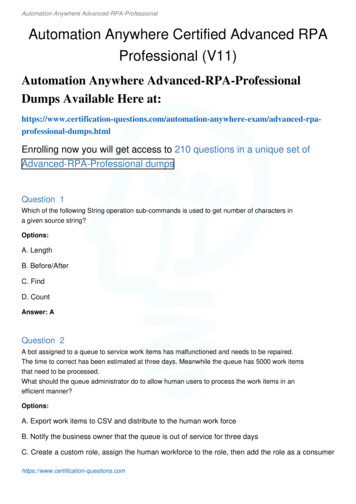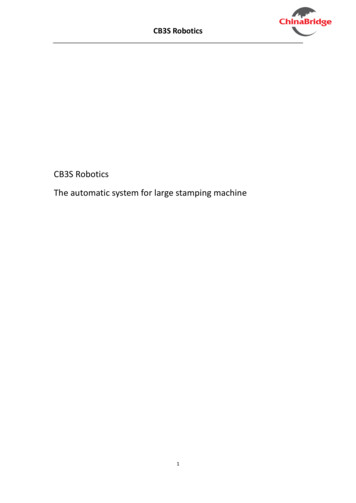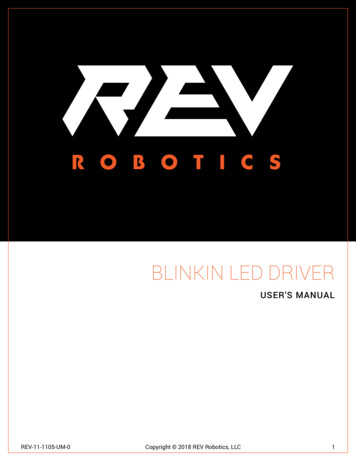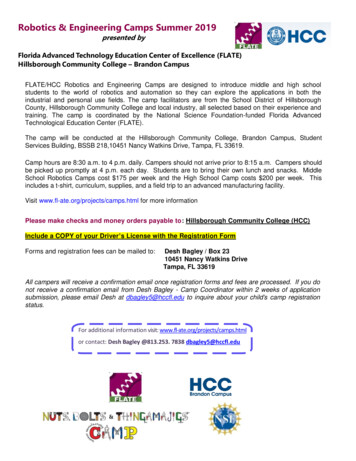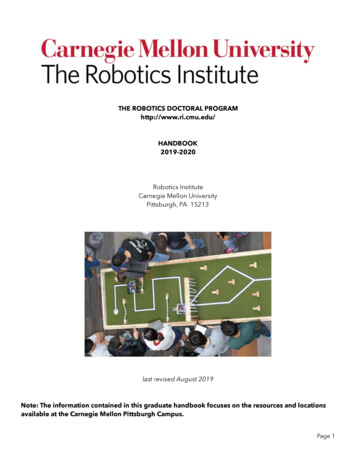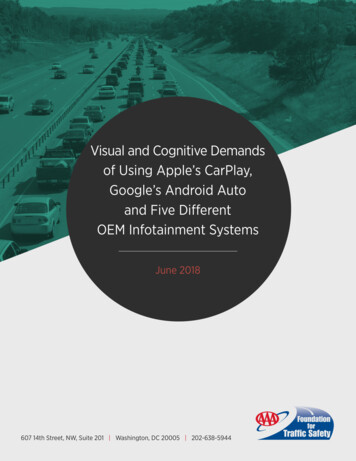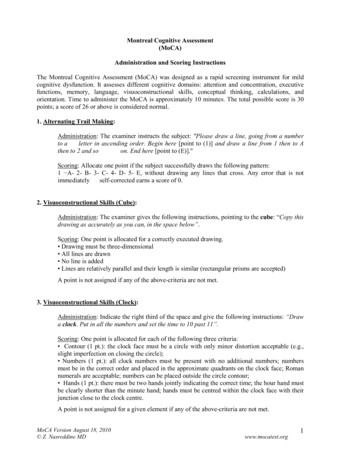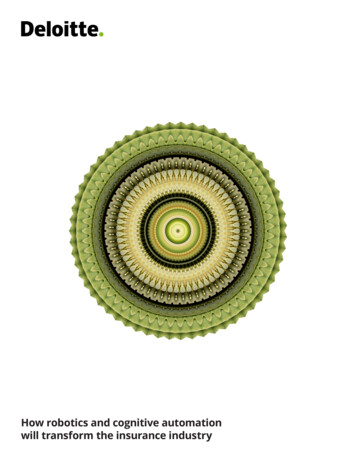
Transcription
How robotics and cognitive automationwill transform the insurance industry
How robotics and cognitive automation will transform the insurance industryContentsIntroduction to robotics and cognitive automation (R&CA)Automation in the insurance industryOperating model reconfigurationA. Impact to employment in the insurance industry1122B. Technological transformation4Focus on customer centricityA. Improved customer experience44B. Increased personalizationR&CA guiding principlesConclusionAppendix5677
How robotics and cognitive automation will transform the insurance industryList of figuresFigure 1. Defining R&CAFigure 2. Transformation of the insurance value chain by R&CAFigure 3. Insurance employment pyramidFigure 4. FTE impact of R&CA on insurance functionsFigure 5. Customer focus vs. cognitive technology adoptionFigure 6. A potential customer interaction using robot agentFigure 7. R&CA guiding principles1233456
How robotics and cognitive automation will transform the insurance industryIntroduction to roboticsand cognitive automationFigure 1: Defining RCA(R&CA)The use of robots to drive tangible businessbenefits is very much a reality today. In fact,the IT-enabled robotic process automation(RPA) market has been growing rapidly at aCAGR of 60.5% from 2014 and is expectedto reach US 5 billion by 2020.1RPA in a pure form, however, is justthe beginning: Cognitive capabilitiesthat enable machines to perform tasksnormally reserved for human intelligenceare now being leveraged with robotics aswell. Cognitive technologies include suchcapabilities as machine learning, naturallanguage processing (NLP), machinevision, emotion recognition, and opticalcharacter recognition, among others.Each of these technologies builds on theexisting competencies of RPA and advancedanalytics, including neural networks, datamining, and Big Data processing. Theresulting combination—termed roboticsand cognitive automation (R&CA)—encompasses a potent mix of automatedskills that finds application acrossindustries. R&CA is expected to fostergreater collaboration between humansand machine by both automating repetitivetasks and enhancing the quality of jobs.R&CA technology is now poised to unlock aworld of possibilities through the synergisticcombination of its key components.Figure 1. Defining R&CARPARules-based automation ofroutine tasksAdvancedanalyticsCapabilities used to analyzeunstructured dataCognitivecapabilitiesCapabilities that mimic human learningand decision makingAutomation in theinsurance industryRPA technology is seeing widespreadadoption across industries, includingfinancial services broadly. However, theinsurance sector has been lagging behindbanking and other financial servicesdomains in its adoption. Insurers have juststarted to run pilot programs to explore thebenefits that RPA can provide in automatingrepetitive processes. Those that have madeinroads are already experiencing positiveresults. The benefits of R&CA, however,go far beyond just efficiency gains. Asfigure 2 below outlines, the potential forR&CA across the insurance value chain is1significant. While RPA is expected to act asa first step in the adoption of automation,cognitive technologies are expected toincreasingly drive automation for the sectorin the not too distant future.In light of this impending transformation, itis important that insurers understand thelong-term business implications of R&CAbeyond robotics alone. This white paperaddresses how the insurance industry willneed to reconfigure its operating model andadopt a more customer-centric approachin order to capitalize on the opportunitiesunlocked through cognitive automation.Robotics and CognitiveAutomation (R&CA)Source: Deloitte analysis
How robotics and cognitive automation will transform the insurance industryFigure 2. Transformation of the insurance value chain by R&CAProduct, underwritingand pricingPolicy administrationand servicingMarketing and salesClaimsCurrent state automation opportunitiesTechnology evolutionRPADevelop newproducts/servicesPerform agent setupCalculate and presentquoteTriage/assign istribution channelsDeliver policyEvaluate fraudLaunch new/enhancedproducts/servicesAdvertise & promoteproducts/servicesProducebill/statementIssue paymentAnalyze market &determine customerneedsManage the sellingprocessPerform invest.accountingPerform reportingLevel of automationLowMedHighFuture state potential use cases Mine social mediainformation, speechanalytics, sentimentanalysis to designcustomized products Robot agent to managecustomer serviceinteractions using naturallanguage processingcapabilities Virtual personalassistant to helpunderwriters identifyadvanced risk attributes Identify preferencepatterns based oncustomer interactions tocreate cross-sell/upsellopportunities Use machine learning toteach systems toautomatically handle allexception processing Use machine vision toassess severity ofdamage using real-timevideo footage Use deep machinelearning techniques toself identify and repairprocess bottlenecks toimprove efficiency Employ social mediainformation to identifyclaim fraud patternsCognitiveSource: Deloitte analysis1Operating model reconfigurationWhile adoption of any new transformationaltechnology warrants reconfiguration ofthe operating model, R&CA is likely to havethe highest impact on the people andtechnology aspects.million jobs (or 7 percent of jobs in the US).A significant portion of this impact would befelt across the insurance industry, given that51 percent of financial jobs are projected tobe transformed by automation by 2019.2A. Impact to employment in theinsurance industryIn most insurance firms, the current deliverypyramid is observed to be significantlybottom heavy with the majority of volumeheavy transactions and reporting processes(regulatory reporting, claims processing,document verification, etc.) being performedby humans. The advent of robotics willOver the next 10 years, automation isexpected to displace 22.7 million existingjobs and create 13.6 million new jobs in theUS economy, resulting in a net job loss of 9.12likely reshape this pyramid as insurersautomate many of these transactions/processes, potentially reducing the sizeand engagement of the bottom and middlelayers of the delivery pyramid, while seeing agrowth in the top layer.Business development, product, andmarketing in response would see a growthin jobs due to a demand for skills in areassuch as data analytics, machine learning,and development of algorithms.
How robotics and cognitive automation will transform the insurance industryThese skills would better enable insurersto build new insurance products usingdynamic pricing strategies based on lifestylepattern intelligence and recognition, whilerunning focused and customized marketingcampaigns.mployment PyramidFigure 3. Insurance employmentpyramid32% –37%25%35%28% –30%40%35% – 38%Current stateFuture stateIT and support functionsOperationsSource: Deloitte analysisProduct dev& marketingOperations, including policy servicing andreporting, would see ever-greater levelsof self-service and automation, as well ascompletely new, highly streamlined digitalprocesses. With requests to back officesdropping significantly, these services willlikely see the steepest FTE shift/migration.In the claims area, R&CA is expected tocreate new roles that would leverage suchtechnologies as machine vision and opticalcharacter recognition to assist humans inadjudicating complex cases.data-intensive jobs and also aid in decisionmaking. This phenomenon, which is widelytermed “bring your own robot,” will likelymake employees more productive andefficient, thereby allowing them to focus oninnovations to help serve customers better.IT and other support functions would seedecreases in FTEs due to reduced overheadas a result of standardized and automatedprocesses and the potential migration tonew strategic data platforms on cloud andother third-party analytical tools. Skill matrix: Insurance firms will needto upskill the different layers of the FTEpyramid in order to re-deploy resourcesinto more complex, judgement-intensiveroles. And underwriters of the future willneed to be equipped with tools that workwith inputs provided by a cognitive systemthat takes into consideration multiplecomplex variables about risk from nontraditional sources such as social media.These shifts might, however, also leadto the creation of more fulfilling jobs inthe transformed insurance landscape.For example, it is a likely scenario thatknowledge workers will have access topersonal cognitive assistants to enableAs FTEs will be required to deliver morevalue-added services/processes, insurancefirms have to be cognizant of the followingkey implications for their service deliverymodel:Figure 4. FTE impact of R&CA on insurance functionsShort-term impact: RPA(1-5 years)Product andunderwritingNew functionsMarketingDigital marketing, campaign managementCustomer segmentation, focused and customized marketingProduct developmentDigital productsCustomized products based on individual preferencesUnderwriting/actuariesN/aCustomer segmentation, focused and customized marketingSales supportChannel managementChannel management through advanced analyticsCustomer managementAutomated complaints and issue managementLifestyle pattern intelligenceNew customer acquisitionAutomated customer onboardingTargeted customer acquisitionPolicy issuanceBusiness rules administrationCognitive analytics enabled self-correcting processesPolicy servicingBusiness rules administrationCognitive analytics enabled self correcting processesRegulatory and businessreportingAutomation of rules-based reporting capabilitiesIntelligent reporting and analysis capabilitiesClaims managementStandard claims management processingAdvanced processing enabled by image recognitionClaims adjustmentAutomated processesMachine vision to assess simple claimsApplication developmentand maintenanceIncreased reliance on third-party serviceprovidersStandardized processes and applicationsInfrastructureIncreased reliance on open source technologiesMigration to cloudHuman resourcesStandardized HR processes, digital recruitmentStandardized HR processes, digital recruitmentFinance, tax, and planningStandardized reportingReduced overheadsOther support functionsReduced overheadsReduced overheadsSource: Deloitte analysis3Long-term impact: R&CA(5-10 years)Increase in FTEsDecrease in FTEs
How robotics and cognitive automation will transform the insurance industryB. Technological transformationInsurers should prepare themselvesfor the imminent R&CA transformationby reconfiguring their IT systems. Thetransformation will be an extension of thejourney that has first begun in such areasas RPA and advanced analytics enablement.The industry will witness the followingtechnology landscape changes on thejourney toward R&CA adoption: Modular sourcing: The R&CAtechnology industry is now engagedin an “disaggregation” phase in whichnimble firms that provide specializedtechnological capabilities are wellpositioned to disrupt the incumbents.These vendors are already providingdisaggregated services on the cloud.For example, one leading ecosystemplayer provides a series of modularservices such as “personality insights,”“visual recognition,” “text analytics,” etc.Through this approach, insurers cansource different capabilities from nichevendors (provided that their underlyingIT architectures are flexible enough totap into these cloud-based services)4 Transparency and control: Cognitivesystems will undoubtedly partner withhumans in the near future. To gain trust inthe robots with whom they are working,humans will need to understand howa particular decision has been arrivedat. Given the nascent stage of R&CAtechnological development, humans areexpected to have the ability to overturnmachine-made decisions. Furthermore,regulators are likely to insist on robustaudit mechanisms. The R&CA systems ofthe future will have to be designed keepingin view all these transparency and controlfeatures.The technological landscape is evolvingquickly, and the implication for insurers isthe need to identify and source relevantcapabilities to allow for better task designand an appropriate division of laborbetween humans and machines.Copyright 2016 Deloitte Development LLC. All rights reserved.Focus oncustomercentricityWith the demographics of insurancecustomers seeing an influx of Millennials,HighGen Xers, and Gen Yers, customerinteraction preferences are changing.According to one survey, approximately 41percent of respondents have left an insurer Integrated systems: R&CA technologybecause of poor customer experience.3has the inherent capability to iterativelyIn another survey, 27 percent of the Genself-learn and generate insights throughYers and 23 percent of Gen Xers who wereaccess to data from multiple sources.questioned indicated that they want toIn order to maximize the returns frominteract with their insurer through digitalthis technology, integration with legacyself-service.4 Customer expectations forsystems and other emerging technologiesconvenience through consistent informationsuch as Big Data, IoT, cloud, etc., must beand service levels across multiple channelsachieved. This will likely lead to a muchor touch points is likely to drive insurers todesired breakdown of walls betweenmirror non-insurance industry experiences,silos of data acrossFigurethe enterprise,7: Customer Focus Vs CognitivesuchTechnologyAdoptionas onlineretail, banking, etc.thereby enabling the establishment of asingle source of truth and delivery of aFigure 5. Customer focus vs. cognitiveunified data model in a significantly moretechnology adoptionconsumable form.Cognitive technology adoptionAs jobs are transformed at all levels acrossthe insurance value chain, it must beunderstood that the technology will notreplace talent as a sustainable competitiveadvantage. New jobs with completelyrenewed job descriptions will be created asa result of this large-scale transformation.Firms that strike a balance betweentransitioning to R&CA on one hand andmaking required FTE adjustments and upskilling their existing workforce on the otherwill likely stand to gain the most.and use these capabilities as “cognitiveoperating systems” in building intelligentapplications.Tech innovator Focus onoperationalefficiency asopposed tocustomer delightRelatively high costof customerretentionMarket winner Better customerexperienceHigher customerretentionEnhanced ability toacquire newcustomersSustainable growthLaggardIneffective Declining mindshareand market share Low Managing talent: Recruitment andtraining engines will have to be upgradedto hire and train skilled FTEs with strongerdomain competencies to handle morecomplex decision-making roles. Along withthe demand for such technical capabilitiesas machine learning and NLP, soft skillssuch as creativity, flexibility, reasoning, andempathy are also likely to be key for talentleaders managing this organizationalchange. A shift toward a highly skilledworkforce would also lead to a need forenhanced talent retention.Limited ability to scaleInability to attract GenX and Gen YRelatively high cost ofcustomer acquisitionHighLowCustomer focusSource: Deloitte analysisInsurers have already started to employadvanced analytics to gain deeper customerinsights. However, the volume, unstructurednature, and velocity of data being generatedis beyond the realm of traditional analyticprocesses. The benefit of cognitivecomputing is that it can solve problems thattraditional analytics cannot readily address.R&CA will help empower insurers with theability to provide an improved customerexperience and more personalized offerings.A. Improved customer experienceUsing social data, interactions can bepersonalized to understand customer needsbetter. Through solutions that understandnatural language, learn and build knowledge,and communicate seamlessly withcustomers, organizations can provide bettercustomer experiences.
How robotics and cognitive automation will transform the insurance industryRobots equipped with language processingcapability could replace human interactionwith customers in areas such as First Noticeof Loss (FNOL) and customer support.Using machine learning techniques, theserobots will be able to iteratively improvetheir understanding of customer queriesand grievances. With advances in emotionrecognition and sensing technology, therobots will also be able to analyze patternsin customer behavior. Insights gained fromthese can be used to provide a unique,personalized customer experience. Withoutemotional wear and tear or natural humanfatigue, robots can be used to achieve scalein quick time, increasing the scope of thistechnology to a wide base of customers.This capability can help the insurer to curateand control the customer experience, whileletting employees focus on more complextasks.“What are my expensesother than HomeLoan EMI, for the pastthree months?” Aquestion that could beanswered by a robot inEnglish without humanintervention.Machine vision is an evolving technologythat is touted to emulate human vision. Ithas found application in the automotiveindustry in such areas as robotic guidanceand quality control, and can be extended tothe assessment of claims. Customers couldpotentially send pictures from an accidentsite and the robot positioned at the otherend would assess the extent of damage.While this feature may not be immediatelyextended to complex claims cases, itcertainly is expected to reduce the handlingtime for simple claims.Time-consuming activities such as frauddetection can be eased by employing entityanalysis techniques using machine learningalong with advanced analytics. At the time ofonboarding, the technology can help bridgethe gap between who customers really areand who they claim to be.5B. Increased personalizationAnother priority for a customer-focusedapproach is to make insurance offeringsmore personalized across customer touchpoints. Personalized products: Historically,the process of rendering underwritingdecisions on a case-by-case basis toaccount for individual applicant riskFigure 6. A potential customerinteraction using robot agent5:50 PM, Monday, Jan 2John is an existing customer of an Insurer@JohnDoe: Upcoming vacation inItaly in February. Really excited about it!!6:00 PM, Monday, Jan 2Cognitive system generates insights about Johnbased on social data and past interactions John is an avid travelerHe likes to engage in highadrenaline sports such as bungeejumping and sky divingBest time to contact John isSaturdays between 4 and 5 PM4:15 PM, Saturday, Jan 7A robotic agent Kiera calls John on his mobileHi John, this is Kiera from your insurancecompany. How are you doing today?I’m doing great. Thanks for asking.This is about your upcoming trip to Italy. Iwanted to offer our insurance services foryour trip .As per Italian embassy website, travelinsurance with medical coverage of 200,000 is mandatory. Also, we can offera customized policy to insure against highrisk sports such as sky diving, bungeejumping, etc.Oh wow! This is extremely helpful. Do youhave products that can cover my entirefamily?Of course. We also offer a customizedfamily travel insurance policy for yourfamily of four. On the mobile app you canreview the product we have designed foryou and would be able to buy instantly.Excellent! Let me do that right away.Source: Deloitte analysisfactors has not been particularly helpful indriving increased product personalization.R&CA technology addresses this challengeby enabling insurers to mine data from awider range of sources than have beentraditionally used, such as connecteddevices and social media. Additionally,automation capabilities provided bythis technology can enable insurers tovirtualize the underwriting process toa large extent, thereby facilitating theirability
Figure 5. Customer focus vs. cognitive technology adoption 4 Figure 6. A potential customer interaction using robot agent 5 . RPA in a pure form, however, is just the beginning: Cognitive capabilities that enable machines to perform tasks . nimble firms tha
